If you’ve got a cactus collection, and it doesn’t contain Rhipsalis, I’m not sure you can call it a collection. Rhipsalis are perhaps the most unusual cactus type on the planet, for many reasons, but they are also incredibly easy to grow.
For the best tips on growing Rhipsalis at home in Australia – and they really do prefer indoor conditions – follow this full guide to make sure you’re growing these Old World cacti in the best way possible.
More...
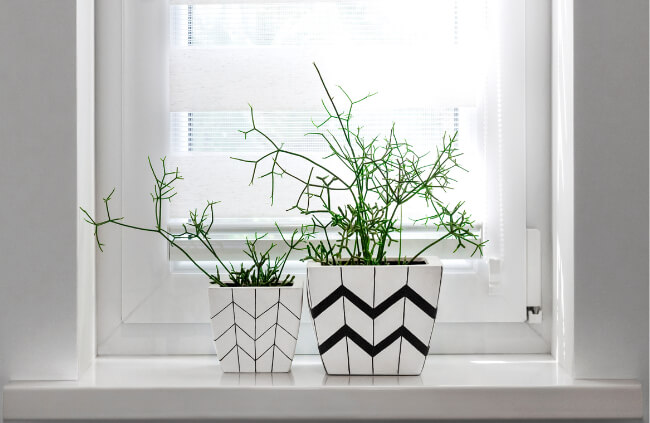
Family: | Cactaceae |
|---|---|
Genus: | Rhipsalis |
Species: | Various |
Origin: | Central and South America, Some in Africa and Asia |
Common Names: | Mistletoe cactus |
Location: | Indoor |
Type: | Cactus |
Growth: | Trailing to 1 m |
Sun requirements: | Bright, indirect light |
Foliage Colour: | Green |
Flower Colour: | White (rare indoors) |
Flowering: | Spring |
Edible Parts: | None |
Maintenance level: | Low |
Poisonous for pets: | Non-toxic to cats and dogs |
What is Rhipsalis?
Rhipsalis is the only type of cactus that grows naturally outside of the Americas. With 35 accepted species, and 25 known in cultivation, it’s well worth getting to know this unusual and diverse cactus genus, which can be grown in all sorts of experimental conditions, as well as standard containers.
As a cactus, they require infrequent watering, but unlike most cactuses, they hold no spine whatsoever, instead, their tubular and succulent stems are able to photosynthesise, splitting into a mess of similar-looking leaves, which do occasionally flower.
In terms of clear visual and habitual similarities, the only truly close cacti species would be the Easter Cactus, or Stenocerus (the Dragon Fruit Cactus).
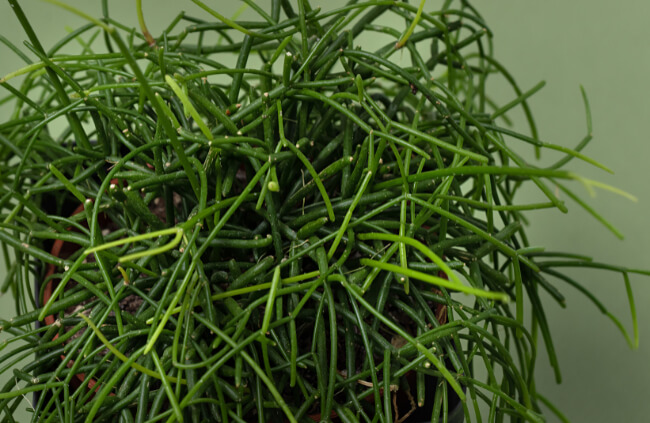
Natural Habitat of Rhipsalis
Rhipsalis, while it’s exciting to think of them as the only cactus found outside of America, are also native to the Americas, and typically found in South America similar to Alstroemerias. However, in isolated tropical parts of Africa and Asia, they are naturally occurring, showing that cacti may have evolved prior to the separation of continents as generally accepted.
Its seeds, though, cast doubt on this theory. The white, translucent berries, similar to mistletoe (hence its common name ‘Mistletoe Cactus’) are slow to digest, and could have travelled the world in the stomach of migrating birds.
Best Rhipsalis Species and Varieties to Grow at Home
Rhipsalis are best known for the drooping, fine leaved, mistletoe cactus, with Rhipsalis baccifera being the most commonly sold in garden centres, and easiest to find online.
However, of the 35 accepted species, there are twenty five that can be found in cultivation fairly commonly that would make a brilliant addition to any cactus or houseplant collection.
1. Rhipsalis agudoensis In many ways, R. agudoensis is nearly identical to the better known Easter cactus. However, its flowers are distinctly different, and its adapted stems are longer, with more of a teardrop shape. This dramatic drooping cactus can be grown in any bright conditions, and while its base might become woody in time, it will continue producing dramatic drooping foliage that can reach up to 2 m in length. | 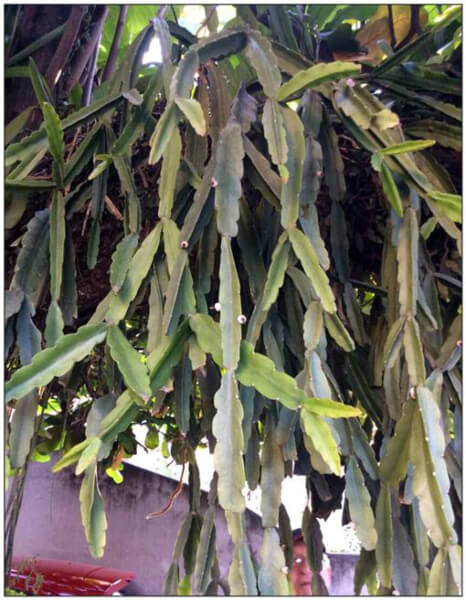 Source: BioOne |
2. Rhipsalis baccifera The smooth, cylindrical stems and leaves of R. baccifera are the best known and easiest to recognise of all varieties. They are not so popular that it’s more likely to find a garden centre with than, than without one. Following a brief cold spell, they become covered in stunning translucent berries, which should be kept away from pets. |  |
3. Rhipsalis burchellii If you like the idea of Rhipsalis, but don’t have the space, try R. burchelli. Its shorter stems and more compact form make it ideal as a tabletop cactus, without the risk of spines. It forms a dense, mossy, mat of green, with gorgeous pale-pink new growth as shoots develop, rarely reaching more than 30 cm long. | 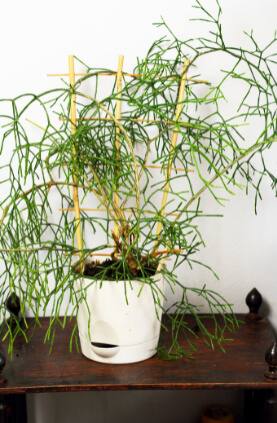 |
4. Rhipsalis campos-portoana Paler, silvery growth, accompanied by amber-coloured berries sets R. campos-portoana apart from its nearest cousin, the common R. baccifera. Both reach similar lengths, but there’s something truly wild about the mature appearance of campos-portoana that really captures the imagination and transports you into the jungle. In the wild, they grow both epiphytically and lithophytically (on rocks) so are great for forgetful plant parents. | 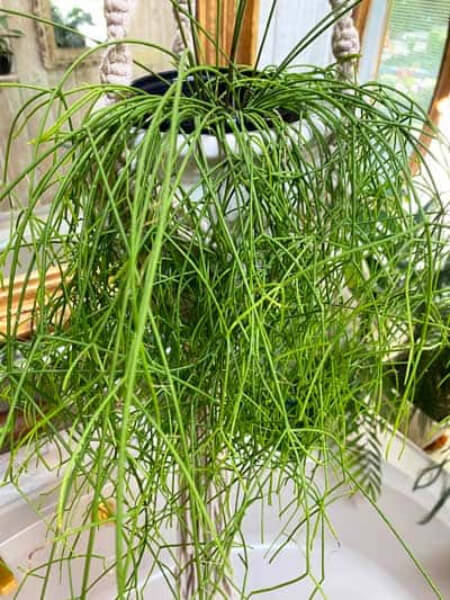 Source: Ohio Tropics |
5. Rhipsalis cereoides If you’re looking for that missing link between typical upright cacti and Rhipsalis, R. cereoides is definitely a contender. Its rigid stems have distinct triangular profiles, which allow it to stand tall while young, before dropping and drooping downwards as the weight of its vigorous stems gets too much. In flower, it’s utterly beautiful, with translucent white petals, followed by pale pink berries. If you’re not lucky enough to see it flowering, don’t worry. That same pale pink tone is often briefly present in its new shoots too. | 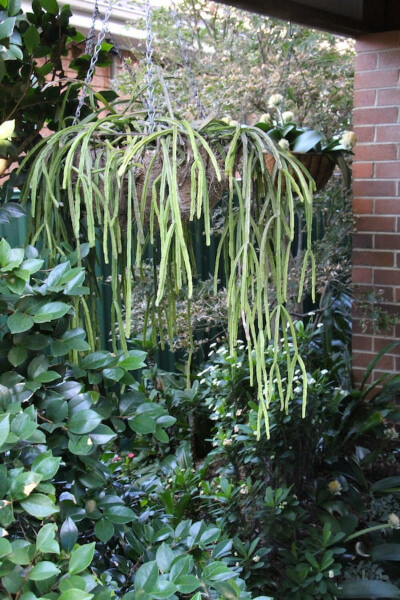 Source: GardenDrum |
6. Rhipsalis cereuscula Also called the ’Rice Cactus’ thanks to its tiny, interlinking rice-like stems, R. cereuscula is a brilliantly unusual compact form of Rhipsalis. Perfect for windowsills and bright living rooms, or even as a pot plant on the balcony when mature. In full flower, the dense dome is covered in frilly white petals, followed by typically pale berries. There are several cultivars of R. cereuscula, some with soft hairs, similar to typical cacti, and others without. | 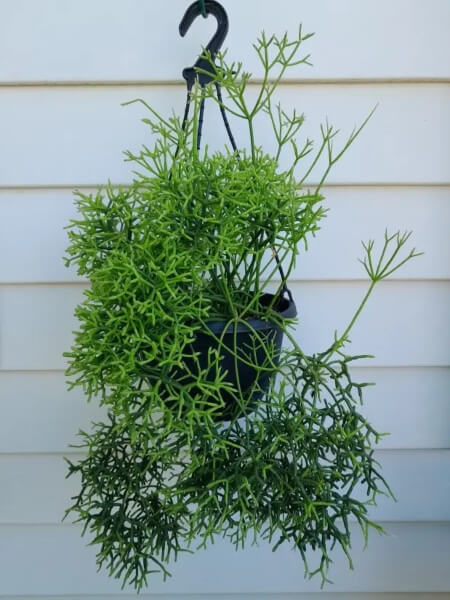 Source: A&J Garden Nursery |
7. Rhipsalis clavata For softer greens, but reliable growth, try getting your hands on R. clavata. Its pale, yellowish stems droop down in incredibly dense clusters, and you can go from cutting to mature plant in a few short years. After flowering, the berries aren’t particularly exciting, other than a burgundy spot on their tip, which thanks to its rapid growth, you get tiers or flowers beforehand, which offer a brief but beautiful chandelier of flowers like no other plant. | 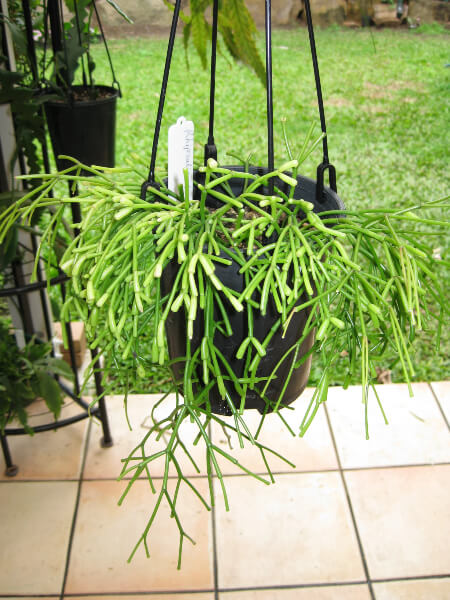 Source: Air Plant Decor |
8. Rhipsalis crispata Another Rhipsalis species with several cultivars in R. crispata. The unusually flat-leaved species has deeply lobed edges, in short sections. Flowers are discrete but ornate, with lightly frilled petals followed by rows of purple berries all the way along the stem. Even mature plants are rarely longer than 1 m, so it’s a great choice for a smaller home or rented accommodation where your main worry is taking your much-loved plants with you. | 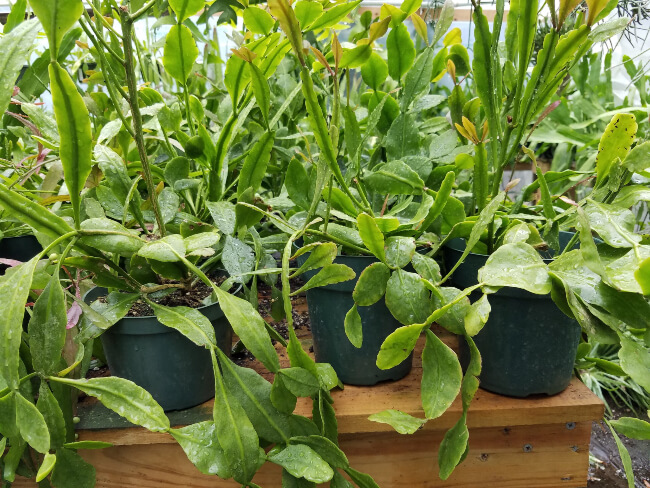 Source: My Gardening House |
9. Rhipsalis cruciformis R. cruciformis is a pretty aggressive looking plant. Its fleshy, succulent stems look like upright cactuses trying to escape their roots, and their tips are tinged with a faded blood-red dye. They are, thankfully, not rare either, which means they are readily available in cultivation, and can be bought as mature plants relatively cheaply too, for instant impact and drama. |  Source: Cactusmania |
10. Rhipsalis elliptica If you’ve ever struggled to grow trailing cactuses before, this may prove a challenge, but R. elliptica – if you’ve got the right conditions at home – will be one of the most beautiful houseplants you’ve ever owned. Its wide leaves, with shallow but pointed lobes, and deep mid-vein are wildly beautiful. The translucency of their fine but thin stems is gorgeous against a bright window or reflective surface, but it also makes them more susceptible to drying out as they are less efficient at holding moisture. Slightly more humid environments are required than typical Rhipsalis care might suggest. | 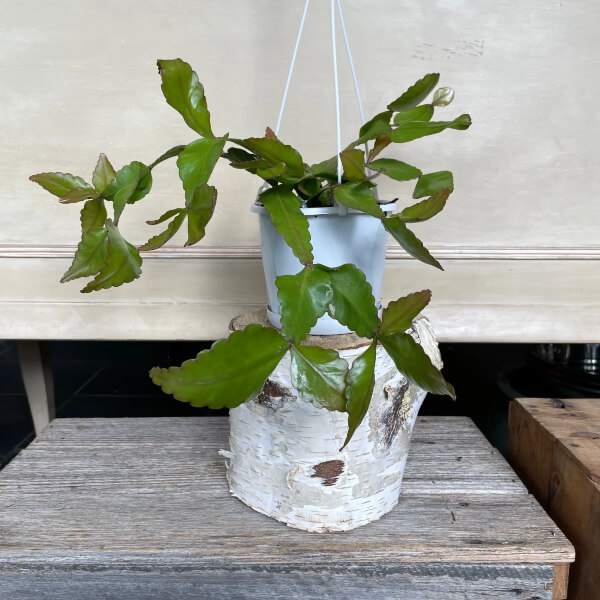 Source: Flair flowers & design |
11. Rhipsalis ewaldiana R. ewaldiana is probably, in my view, the plant that was first discovered when the name ‘mistletoe cactus’ was given to this genus. Its round, mounding form seems to fight gravity to create a globe of green growth, covered in iconically translucent, creamy, berries. A great addition to your home if you have the space, but can reach 1 m wide, as well as 1.5-2 m down. | 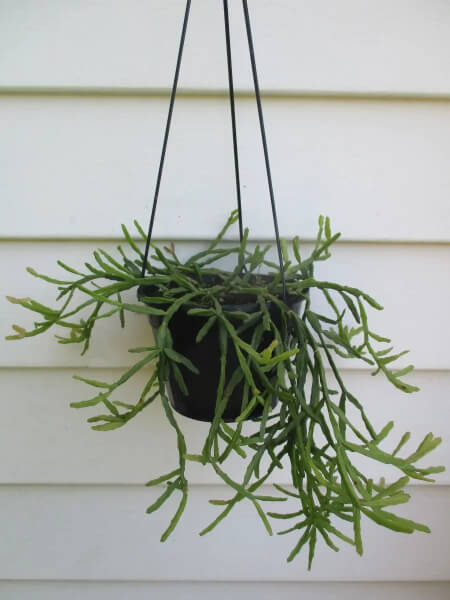 Source: A&J Garden Nursery |
12. Rhipsalis floccosa The matt leaved R. floccosa – with several subspecies and cultivars, is quite unique, not in its shape, but in its texture. Its stems are incredibly matt, and its mottled flowers have an amber sheath, giving them quite a dirty hue. I’m perhaps not selling it well, but this is one of the best Rhipsalis species you can grow if you’re trying to create a more naturalistic, jungle effect in your home. | 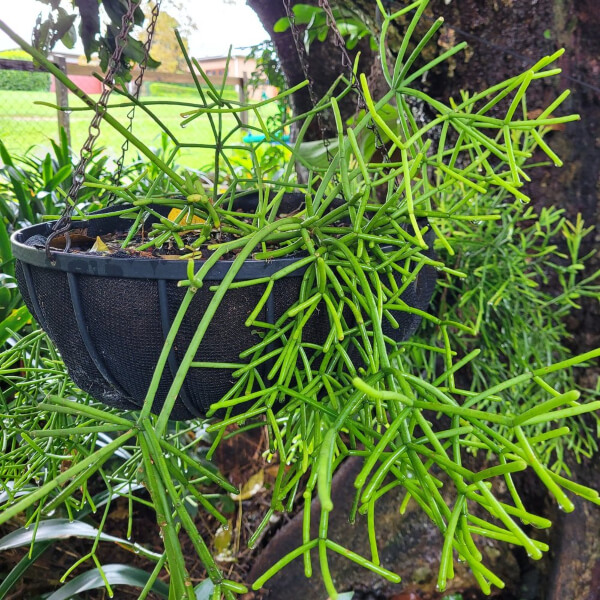 Source: Succulents Online |
13. Rhipsalis goebeliana Long, lobed, cherry leaf-shaped stems with visible veins through to flowering points make R. goebeliana my out-and-out favourite species. Masses of glowing white flowers burst out at once from the soft green stems. It’s not the most dramatic, and it’s not the fastest growing, but it’s completely unique, and flowers surprisingly reliably in southern parts of the country. | 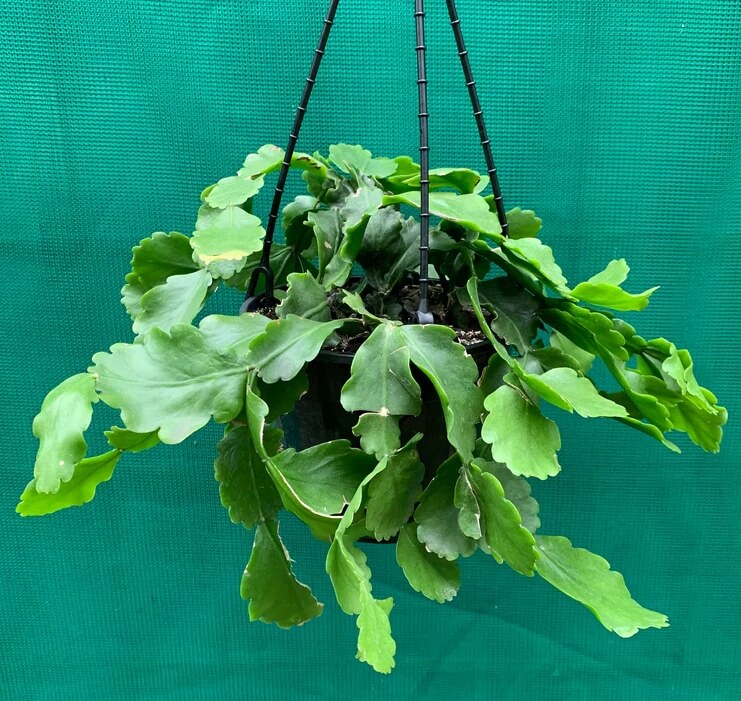 Source: Air Plant Decor |
14. Rhipsalis grandiflora When Rhipsalis evolved into R. grandiflora, it must have done it for a reason, but I’m honestly not sure what that reason was. If you’re looking for interesting cultivars and species to grow at home, this is definitely one of them, but it’s one of the clumsiest looking plants you could dream of owning. Its thick, finger width green stems are fleshy, lumpy, and flower sporadically, while the stems themselves tend to form loose groups, rather than dense mounds. | 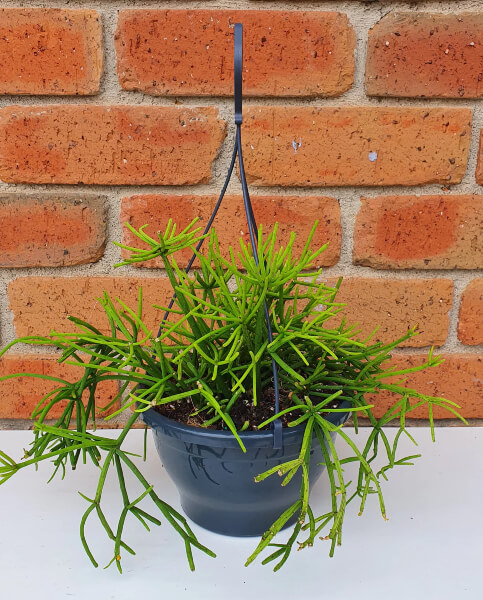 Source: That Foliage Life |
15. Rhipsalis mesembryanthemoides Now here’s a plant worth seeking out. R. mesembryanthemoides develops the densest clusters of stems and adapted leaves of any Rhipsalis. They form, when young, into upright pyramidal structures, before drooping into sweeping, swirling, trailing plants that root easily from the stems, and flower reliably in most conditions. They are slow growing, and rarely sold in anything bigger than 5 cm pots, but it’s worth the wait! |  Source: World of Succulents |
16. Rhipsalis micrantha / kirbergii A long-stemmed Rhipsalis, with a triangular stem-profile is R. micrantha, also known as R. kirbergii (these are both accepted synonyms of the same plant). R. micranta can be grown in full sun, provided you regularly check its soil moisture, which makes it a wonderful choice for a low-maintenance house plant that offers dappled shade to others. | 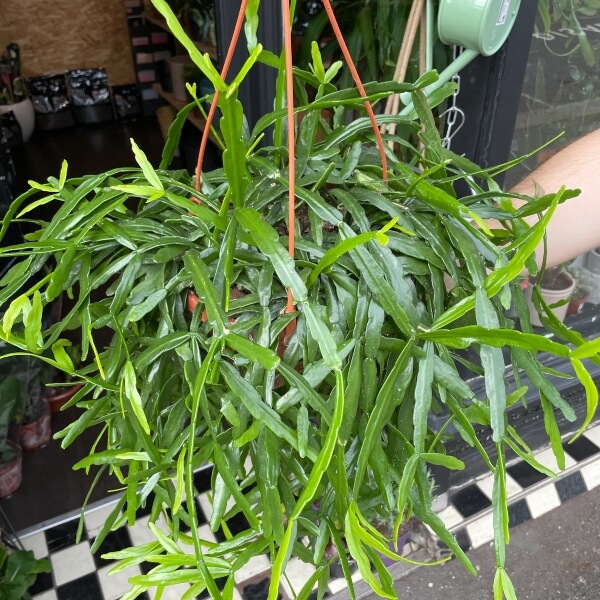 Source: Urban Tropicana |
17. Rhipsalis oblonga Rhipsalis have natural colourations that are covered by chlorophyll. In most cases, that makes them green. When R. oblonga is left slightly too long without water, that colouration, drained of protective chlorophyll, leaves a gorgeous pinky-orange hue to each and every leaf. It’s a rare sight, but a wonderful way that these plants can tell you when they need a drink. |  Source: Rhipsalis.com |
18. Rhipsalis pachyptera The yellow and white flowers of R. pachyptera resemble half-popped popcorn, and stand out gloriously against the gorgeous green foliage. When stressed, like R. oblonga, these plants develop red hues, often during flowering as nutrients are directed to flowers and seed production. | 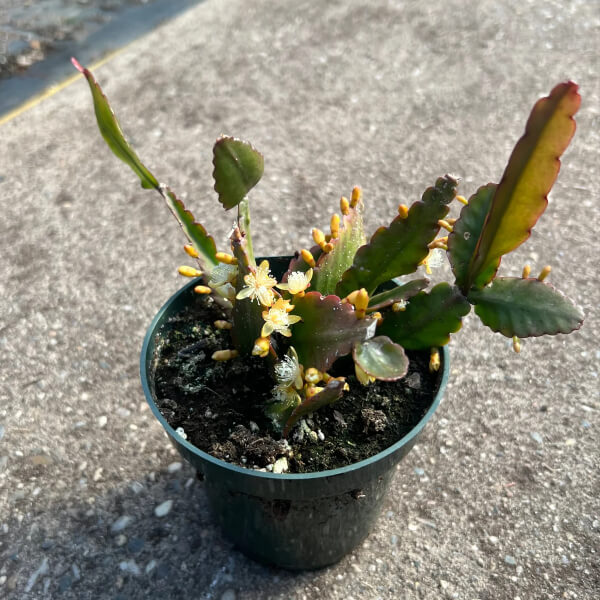 Source: Fantastic Gardens |
19. Rhipsalis paradoxa R. paradoxa got its name, I assume, because it’s really quite hard to get your head around how its stems function. Each stem section is at odds with the last, creating a fascinating alternation of triangular cross-sections, with wings interlocking throughout the plant. When given proper care, R. paradoxa can reach 1.5 m long indoors, providing one of the most fascinatingly confusing houseplants you will ever encounter. | 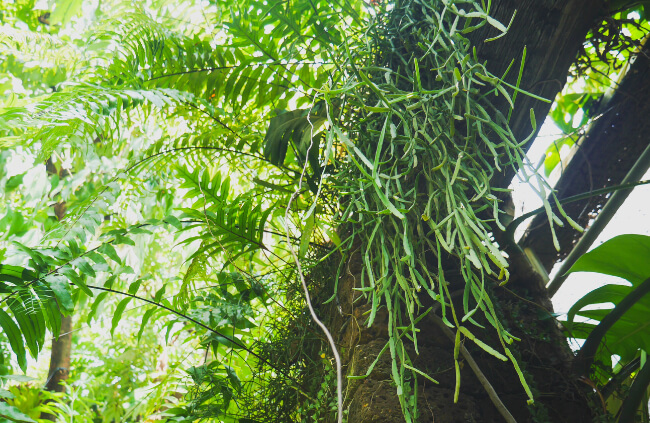 |
20. Rhipsalis pentaptera R. pentaptera, yet another long stemmed, fleshy, Rhipsalis species is leggy, unwieldy, and generally quite cumbersome, but it’s got a unique beauty all to itself, thanks to its ridged and shallow-lobed stems, offering interest and architectural interest all year round. | |
21. Rhipsalis pilocarpa Most Rhipsalis species bear little resemblance to the wider cactus family, or at least to the cacti we most commonly recognise, with fury or sharp spines. R. pilocarpa is different though. It’s covered in tiny fibrous hairs that will stick in your skin if you touch it. That danger is masked by gorgeously structural star-shaped flowers, and bright red berries if pollinated. | 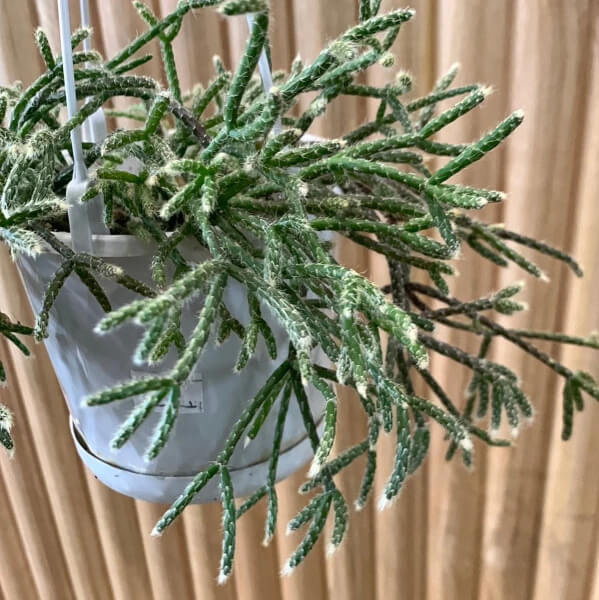 Source: My Jungle Home |
22. Rhipsalis platycarpa This flat-leaved Rhipsalis shoots new stems from pretty much every flowering point, creating masses of interlocking, tangled stems after not much time at all. If you’re after quick-growing houseplants that are fast to establish, and offer something a little out of the ordinary, try to source one of these breath-taking Rhipsalis for yourself. | 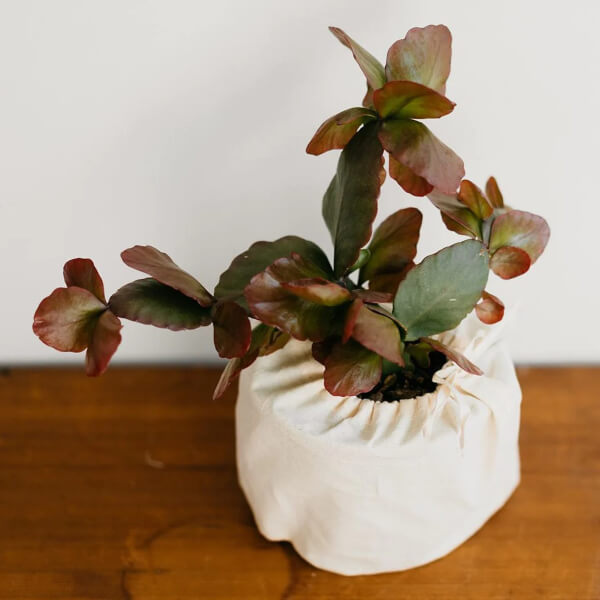 Source: GreenHouse Co |
23. Rhipsalis ramulosa Long, pink-tinged leaves with a delicate papery texture are the defining characteristic of R. ramulosa, whose flowers and stems develop from spines around the edge of each section. Blotchy, uneven, and untrainable sum up R. ramulosa pretty well, but that doesn’t stop it from being one of the most gorgeously show-stopping Rhipsalis species there is. |  Source: Ollie's Blooms & Plants |
24. Rhipsalis rhombea Small flowers do occasionally form on R. rhombea, but they are rare, meaning it’s really quite easy to grow, and you don’t risk challenged plants trying to go to seed as a last resort. For anyone looking for really simple options to grow at home, this is a neat bullet-proof Rhipsalis species that can be grown anywhere in Australia. | 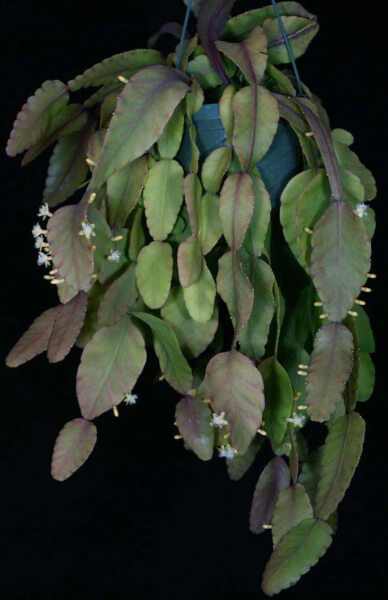 Source: Tropiflora |
25. Rhipsalis teres From a distance, R. teres look distinctly like R. baccifera, but there’s more going on than meets the eye. Its stems branch off more readily, from more points, creating intensely compact growth that rarely droops further than 1 m. For most homes, R. teres is a much more practical option than its common counterpart, but it’s frustratingly hard to get hold of. | 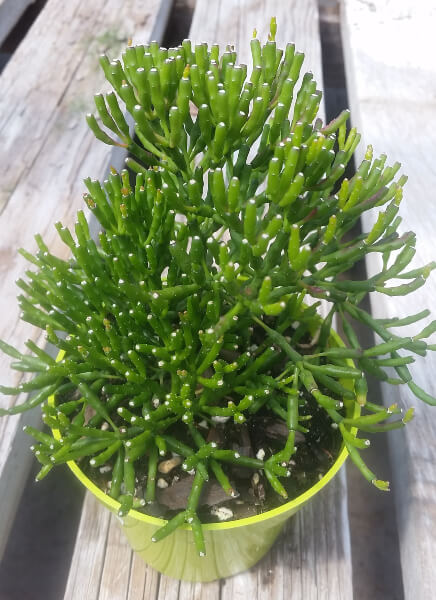 Source: Sunnyside Gardens |
1. Rhipsalis agudoensis

Source: BioOne
In many ways, R. agudoensis is nearly identical to the better known Easter cactus. However, its flowers are distinctly different, and its adapted stems are longer, with more of a teardrop shape.
This dramatic drooping cactus can be grown in any bright conditions, and while its base might become woody in time, it will continue producing dramatic drooping foliage that can reach up to 2 m in length.
2. Rhipsalis baccifera


Get Your Free Guide:
Master Growing Australian Natives eBook
A Must Have Complete Guide for Every Australian Garden
Get Your Free Guide:
Master Growing Australian Natives eBook
A Must Have Complete Guide for Every Australian Garden

The smooth, cylindrical stems and leaves of R. baccifera are the best known and easiest to recognise of all varieties. They are not so popular that it’s more likely to find a garden centre with than, than without one.
Following a brief cold spell, they become covered in stunning translucent berries, which should be kept away from pets.
3. Rhipsalis burchellii

If you like the idea of Rhipsalis, but don’t have the space, try R. burchelli. Its shorter stems and more compact form make it ideal as a tabletop cactus, without the risk of spines.
It forms a dense, mossy, mat of green, with gorgeous pale-pink new growth as shoots develop, rarely reaching more than 30 cm long.
4. Rhipsalis campos-portoana

Source: Ohio Tropics
Paler, silvery growth, accompanied by amber-coloured berries sets R. campos-portoana apart from its nearest cousin, the common R. baccifera.
Both reach similar lengths, but there’s something truly wild about the mature appearance of campos-portoana that really captures the imagination and transports you into the jungle. In the wild, they grow both epiphytically and lithophytically (on rocks) so are great for forgetful plant parents.
5. Rhipsalis cereoides

Source: GardenDrum
If you’re looking for that missing link between typical upright cacti and Rhipsalis, R. cereoides is definitely a contender. Its rigid stems have distinct triangular profiles, which allow it to stand tall while young, before dropping and drooping downwards as the weight of its vigorous stems gets too much.
In flower, it’s utterly beautiful, with translucent white petals, followed by pale pink berries. If you’re not lucky enough to see it flowering, don’t worry. That same pale pink tone is often briefly present in its new shoots too.
6. Rhipsalis cereuscula

Source: A&J Garden Nursery
Also called the ’Rice Cactus’ thanks to its tiny, interlinking rice-like stems, R. cereuscula is a brilliantly unusual compact form of Rhipsalis. Perfect for windowsills and bright living rooms, or even as a pot plant on the balcony when mature.
In full flower, the dense dome is covered in frilly white petals, followed by typically pale berries. There are several cultivars of R. cereuscula, some with soft hairs, similar to typical cacti, and others without.
7. Rhipsalis clavata

Source: Air Plant Decor
For softer greens, but reliable growth, try getting your hands on R. clavata. Its pale, yellowish stems droop down in incredibly dense clusters, and you can go from cutting to mature plant in a few short years.
After flowering, the berries aren’t particularly exciting, other than a burgundy spot on their tip, which thanks to its rapid growth, you get tiers or flowers beforehand, which offer a brief but beautiful chandelier of flowers like no other plant.
8. Rhipsalis crispata

Source: My Gardening House
Another Rhipsalis species with several cultivars in R. crispata. The unusually flat-leaved species has deeply lobed edges, in short sections.
Flowers are discrete but ornate, with lightly frilled petals followed by rows of purple berries all the way along the stem. Even mature plants are rarely longer than 1 m, so it’s a great choice for a smaller home or rented accommodation where your main worry is taking your much-loved plants with you.
9. Rhipsalis cruciformis

Source: Cactusmania
R. cruciformis is a pretty aggressive looking plant. Its fleshy, succulent stems look like upright cactuses trying to escape their roots, and their tips are tinged with a faded blood-red dye.
They are, thankfully, not rare either, which means they are readily available in cultivation, and can be bought as mature plants relatively cheaply too, for instant impact and drama.
10. Rhipsalis elliptica

Source: Flair flowers & design
If you’ve ever struggled to grow trailing cactuses before, this may prove a challenge, but R. elliptica – if you’ve got the right conditions at home – will be one of the most beautiful houseplants you’ve ever owned.
Its wide leaves, with shallow but pointed lobes, and deep mid-vein are wildly beautiful. The translucency of their fine but thin stems is gorgeous against a bright window or reflective surface, but it also makes them more susceptible to drying out as they are less efficient at holding moisture. Slightly more humid environments are required than typical Rhipsalis care might suggest.
11. Rhipsalis ewaldiana

Source: A&J Garden Nursery
R. ewaldiana is probably, in my view, the plant that was first discovered when the name ‘mistletoe cactus’ was given to this genus.
Its round, mounding form seems to fight gravity to create a globe of green growth, covered in iconically translucent, creamy, berries. A great addition to your home if you have the space, but can reach 1 m wide, as well as 1.5-2 m down.
12. Rhipsalis floccosa

Source: Succulents Online
The matt leaved R. floccosa – with several subspecies and cultivars, is quite unique, not in its shape, but in its texture. Its stems are incredibly matt, and its mottled flowers have an amber sheath, giving them quite a dirty hue.
I’m perhaps not selling it well, but this is one of the best Rhipsalis species you can grow if you’re trying to create a more naturalistic, jungle effect in your home.
13. Rhipsalis goebeliana

Source: Air Plant Decor
Long, lobed, cherry leaf-shaped stems with visible veins through to flowering points make R. goebeliana my out-and-out favourite species. Masses of glowing white flowers burst out at once from the soft green stems.
It’s not the most dramatic, and it’s not the fastest growing, but it’s completely unique, and flowers surprisingly reliably in southern parts of the country.
14. Rhipsalis grandiflora

Source: That Foliage Life
When Rhipsalis evolved into R. grandiflora, it must have done it for a reason, but I’m honestly not sure what that reason was. If you’re looking for interesting cultivars and species to grow at home, this is definitely one of them, but it’s one of the clumsiest looking plants you could dream of owning.
Its thick, finger width green stems are fleshy, lumpy, and flower sporadically, while the stems themselves tend to form loose groups, rather than dense mounds.
15. Rhipsalis mesembryanthemoides

Source: World of Succulents
Now here’s a plant worth seeking out. R. mesembryanthemoides develops the densest clusters of stems and adapted leaves of any Rhipsalis. They form, when young, into upright pyramidal structures, before drooping into sweeping, swirling, trailing plants that root easily from the stems, and flower reliably in most conditions.
They are slow growing, and rarely sold in anything bigger than 5 cm pots, but it’s worth the wait!
16. Rhipsalis micrantha / kirbergii
Source: Urban Tropicana
A long-stemmed Rhipsalis, with a triangular stem-profile is R. micrantha, also known as R. kirbergii (these are both accepted synonyms of the same plant).
R. micranta can be grown in full sun, provided you regularly check its soil moisture, which makes it a wonderful choice for a low-maintenance house plant that offers dappled shade to others.
17. Rhipsalis oblonga

Source: Rhipsalis.com
Rhipsalis have natural colourations that are covered by chlorophyll. In most cases, that makes them green. When R. oblonga is left slightly too long without water, that colouration, drained of protective chlorophyll, leaves a gorgeous pinky-orange hue to each and every leaf.
It’s a rare sight, but a wonderful way that these plants can tell you when they need a drink.
18. Rhipsalis pachyptera

Source: Fantastic Gardens
The yellow and white flowers of R. pachyptera resemble half-popped popcorn, and stand out gloriously against the gorgeous green foliage.
When stressed, like R. oblonga, these plants develop red hues, often during flowering as nutrients are directed to flowers and seed production.
19. Rhipsalis paradoxa

R. paradoxa got its name, I assume, because it’s really quite hard to get your head around how its stems function.
Each stem section is at odds with the last, creating a fascinating alternation of triangular cross-sections, with wings interlocking throughout the plant.
When given proper care, R. paradoxa can reach 1.5 m long indoors, providing one of the most fascinatingly confusing houseplants you will ever encounter.
20. Rhipsalis pentaptera

Source: The National Gardening Association
R. pentaptera, yet another long stemmed, fleshy, Rhipsalis species is leggy, unwieldy, and generally quite cumbersome, but it’s got a unique beauty all to itself, thanks to its ridged and shallow-lobed stems, offering interest and architectural interest all year round.
21. Rhipsalis pilocarpa

Source: My Jungle Home
Most Rhipsalis species bear little resemblance to the wider cactus family, or at least to the cacti we most commonly recognise, with fury or sharp spines. R. pilocarpa is different though. It’s covered in tiny fibrous hairs that will stick in your skin if you touch it.
That danger is masked by gorgeously structural star-shaped flowers, and bright red berries if pollinated.
22. Rhipsalis platycarpa

Source: GreenHouse Co
This flat-leaved Rhipsalis shoots new stems from pretty much every flowering point, creating masses of interlocking, tangled stems after not much time at all.
If you’re after quick-growing houseplants that are fast to establish, and offer something a little out of the ordinary, try to source one of these breath-taking Rhipsalis for yourself.
23. Rhipsalis ramulosa

Source: Ollie's Blooms & Plants
Long, pink-tinged leaves with a delicate papery texture are the defining characteristic of R. ramulosa, whose flowers and stems develop from spines around the edge of each section.
Blotchy, uneven, and untrainable sum up R. ramulosa pretty well, but that doesn’t stop it from being one of the most gorgeously show-stopping Rhipsalis species there is.
24. Rhipsalis rhombea

Source: Tropiflora
Small flowers do occasionally form on R. rhombea, but they are rare, meaning it’s really quite easy to grow, and you don’t risk challenged plants trying to go to seed as a last resort.
For anyone looking for really simple options to grow at home, this is a neat bullet-proof Rhipsalis species that can be grown anywhere in Australia.
25. Rhipsalis teres

Source: Sunnyside Gardens
From a distance, R. teres look distinctly like R. baccifera, but there’s more going on than meets the eye. Its stems branch off more readily, from more points, creating intensely compact growth that rarely droops further than 1 m.
For most homes, R. teres is a much more practical option than its common counterpart, but it’s frustratingly hard to get hold of.
How to Grow Rhipsalis in Australia
Rhipsalis are fairly indestructible plants. And I say that as a fairly hopeless cactus parent. Their roots like to dry out and enjoy good aeration, so poor soil helps. In fact, my three Rhipsalis plants (all gifted about ten years ago) are much happier today in completely used compost, than they were when they were new.
In most parts of Australia, this plant should be grown indoors, in controlled conditions, but they do grow happily outdoors in warmer parts of the country, either in hanging baskets or as epiphytes.
Essentially, if you give them enough sun, nutrients, and balanced moisture levels throughout the year, they’re fine. Just don’t let them drop below 10°C at any point, as it will weaken them. Anything below 5°C will kill them pretty much overnight.

Growing Rhipsalis Indoors
The most common conditions for growing this plant in Australia are bright conditions indoors, with full sun, and free-draining compost. There is some debate over how best to aerate the roots of these epiphytic plants when grown indoors, but basically, if you avoid over watering them, and add a few extra drainage holes to your containers, they should be ok.
Choosing the Best Container for Rhipsalis
Before you get started, find the right container for your Rhipsalis plants. Most collectors swear religiously by terracotta containers, because they dry out sooner than plastic, which means you can water deeply with less risk of stagnant water.
If you prefer plastic pots for hygiene, then don’t place them inside an outer decorative pot as humidity will build around your compost. Simply hang the plastic pots as they are, and make sure there are at least five good-sized drainage holes for a 20 cm pot, or equivalent on larger containers (this ensures both drainage, and root aeration).
Best Compost for Rhipsalis
Rhipsalis are cacti, so cactus compost mixes are ideal. If you can’t find a pre-mixed cactus compost in your local garden centre, don’t worry, it’s easy enough to make your own. You’ll need a few basic ingredients, and a tub to mix them.
To make your cactus compost, you’ll need:
- Any organic compost with fine organic matter (garden compost is fine, but sieve it down to 1 cm grade) – 30%
- Coarse sand, or horticultural grit (any clean grit under 3mm) - 30%
- Vermiculite – 30%
- Perlite – 30%
You can use just perlite or vermiculite, rather than both, but they have different properties so I prefer to use equal parts of both for nutrient retention and aeration.
Water Schedule
This plant don’t mind drying out, and while the general advice is to water them once a week, it depends heavily on their position, where you live, and the temperatures indoors.
Our home is rarely above 21°C, and our Rhipsalis hang about 3 ft away from a bright north-westerly window. They take about three weeks to dry out completely, so we water once a fortnight, and feed them annually with a drip feed.
Sun Requirements
Rhipsalis prefer bright conditions provided the temperature stays roughly above 18°C, and can cope with full sun in the mornings and evenings.
Consider their natural habitat as epiphytic plants, constantly shaded by the dappling foliage of the trees they hang from. In the wild they would never be exposed to direct sun, so replicating that at home is the best way to keep them happy.
How to Propagate Rhipsalis
Rhipsalis are really easy to propagate. In fact, if you’ve got one growing at home, chances are it’s already done it for you. Their stems will root into bare soil, so often create new plants within their own pots, beneath their existing mass of leaves and stems.
To create new plants from your existing plants, simply divide them by teasing apart the top growth until to find the base of each section. Remove what you need and infill any gaps with a fresh cactus potting mix.
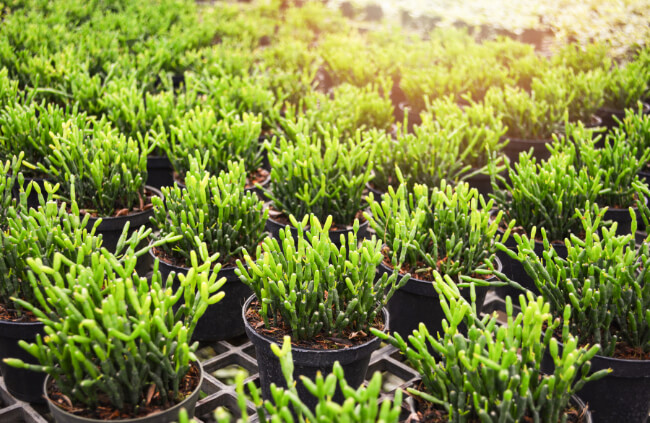
Propagating Rhipsalis from Cuttings
Any 10 cm piece of mistletoe cactus will root in bright indirect light, with reasonable moisture and some patience.
- Simply cut a 10 cm section of Rhipsalis stem (remember which side is up!).
- Create a hole in a small pot filled with cactus potting mix.
- Insert the stem so the end that was closest to the base of the plant is now in the soil.
- Water it well and leave it somewhere bright.
- Keep the cutting moist by misting when it dries out.
- You should have a rooted Rhipsalis cutting after about five weeks.
Rhipsalis Propagation from Seeds
If you’re lucky enough to have pollinated flowers, followed by ripe weeds on your Rhipsalis, they can be propagated from fresh seeds very easily. Either squash the berries directly into a pot with sphagnum moss, or coir fibre, or squeeze out the seeds and sow them once clean.
(Previously, we advocated for the use of peat/sphagnum moss. However, recognizing its environmental consequences, we've modified our guidance to highlight eco-conscious alternatives that deliver comparable or superior benefits. Refer to our comprehensive guide to learn more about peat moss and its alternatives.)
The first option is easier as the seeds are tiny, but the second option reduces the chance of mould developing from decomposing berries. Cover the pots with a plastic bag, and keep them but not soaking. Store them somewhere bright, but out of direct sunlight.
Seeds can take about three months to germinate, so keep them moist, and blow air into the bag each time too (CO2 helps seeds and seedlings develop).
Rhipsalis Care Tips
Rhipsalis mostly care for themselves, but the more care you give them, the faster you’ll get a dramatic and mature plant. Remember, Rhipsalis, similar to Epiphyllum, are epiphytes and cactus, two groups of plants that are well-adapted to recover after most challenges.
The only thing to seriously avoid is overwatering, which can completely kill them, and rot them from the inside out. Avoid overwatering, and the rest is simple.
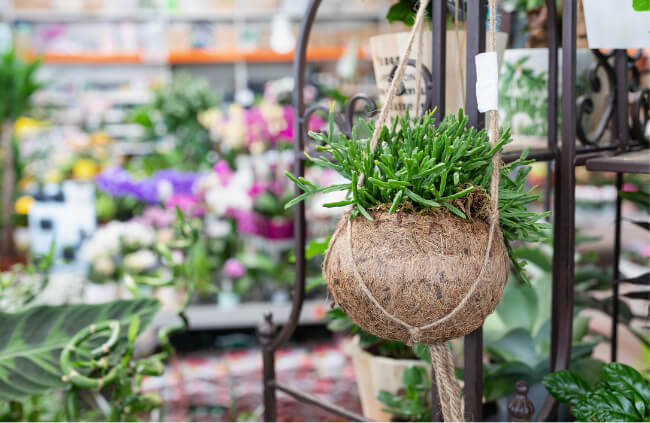
Feeding Rhipsalis
This plant don’t need feeding, but I like to pop a basic house plant drip feed into the compost once a year just to top up nutrients in a similar way that they’d get them in nature from decomposing leaves in crevices in bark, or branch joints (rather than regular boosts of liquid feed).
Pruning Needs
Rhipsalis don’t need pruning, but you should remove any orange leaves, grey leaves, or brown foliage that is dropping back to the source of the problem. If that means cutting your plants right to the base, then so be it. If you don’t, problems can spread, so it’s better to be safe than sorry.
Repotting
This plant don’t need repotting regularly, but if they are starting to expand their plastic pots, it’s worth giving them a pot that’s an extra 1” wide but the same depth.
Root restriction isn’t a bad thing for this plant, so let them become slightly pot-bound for a year before repotting, as this can often trigger quite vigorous new growth.
Encourage Rhipsalis to Flower
Temperatures need to drop below 18°C for at least two weeks to trigger into a period of flowering, followed by berries. The flowers can then be manually pollinated indoors, or left to be pollinated by insects outdoors if you want to enjoy the unusual seeds, or harvest and propagate the seeds yourself.
Common Rhipsalis Pests and Diseases
There’s not much that can go wrong with Rhipsalis. Avoid over-caring, and over-watering as they can both cause common problems, and encourage pests like mealybug. For more detail on specific pests and diseases, see below.
We once found a slug hiding around the base of our Rhipsalis. It hadn’t done any damage, but it was a pretty big shock. Like most cactuses, it doesn’t really offer much to pests, so other than mealybugs, you should be ok.
If you do notice mealybugs (small insects with a white coating) wipe them off, and let the soil; dry out. They lay their eggs in damp soil, and they can’t develop if the soil dries out. Your plant will recover if left for a month without water, but the mealybugs won’t. Problem solved!
No specific diseases will target Rhipsalis, so simply avoid over-watering or over-feeding, and make sure humidity is at average or slightly near average levels, with good air general flow in the room.
Over watered or over-humidified roots can rot, causing stem rot in turn. Spotting the damage can be tough, so by the time you realise it’s often too late. If you do notice root rot on your Rhipsalis or any other cactus, just remove it from the soil entirely and allow the roots to dry out before repotting into fresh soil.
It isn’t a definite fix, but if the base of your cactus is turning brown and mushy, and the roots are blackening, it’s better to try something than nothing.
A second insurance policy is to follow the guide for rooting cuttings from healthy top growth earlier in this article too.
Rhipsalis Frequently Asked Questions
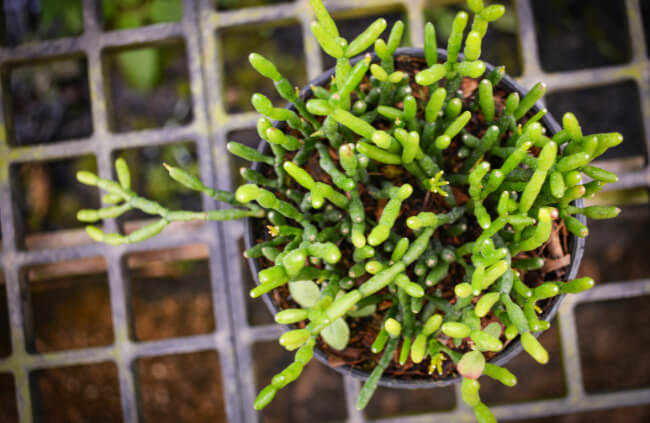
How do you take care of Rhipsalis in the winter?
During winter, try to keep Rhipsalis at temperatures above 15°C (10°C as a minimum) through the winter, and make sure the soil stays reasonably dry, as humidity can be a problem in colder months.
Is Rhipsalis easy to grow?
Rhipsalis is an easy plant to grow, with very few regular care requirements at all. If you struggle to grow houseplants, but love the idea of hanging, dramatic, structural foliage at home, Rhipsalis are a great low-maintenance plant.
Can you divide Rhipsalis?
The easiest way to propagate Rhipsalis and create new plants is to divide it. Simply look for distinct bases to stems on the surface of the soil. Small rooted plants can be pricked out, but larger sections can be divided by slicing through the root ball.
Can you grow Rhipsalis outside?
Rhipsalis will grow happily outdoors in Australia, provided it is protected from heavy rainfall, and temperatures below 10°C.
Can you root Rhipsalis in water?
You can root Rhipsalis in water quite easily, but it's best to root it into compost if possible. Cacti produce roots that are generally called water-roots, which are adapted to water conditions, and can get easily infected when moved into compost later.
Wrapping Up Our Rhipsalis Growing Guide
Rhipsalis are great plants for new houseplant keepers, or anyone whose green thumb is a little rusty. They are basically indestructible, and even if you do manage to kill them, they’re so easy to propagate from cuttings that you won’t be without them for long.
Now, with all that said, it is still important to take care of these plants, and that starts by finding the right spot. Bright, indirect light, with ready but irregular watering is all you need, and then you can grow Rhipsalis anywhere in Australia, indoors or out.
Published on August 10, 2023 by Maisie Blevins
Last Updated on October 18, 2025




